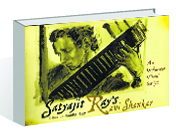|
A Ray that never shone
Reviewed by Suresh Kohli
Satyajit Ray's Ravi
Shankar: An Unfilmed Visual Script
Edited by Sandip Ray
Collins, an imprint of HarperCollins Publishers India. Pages 108. Rs
399.
 As
in life, so also in death. The mystery persists. When exactly Satyajit
Ray worked on a visual script, A Sitar Recital by Ravi Shankar,
for a possible film on sitar maestro, Ravi Shankar ó before Pather
Panchali, their first of the four collaborations, the other three
being Aparajito, Paras Pathar and Apur Sansar after
which the filmmaker also took over the mantle of the music director
for his own films. His biographer, Marie Setonís claim that the
storyboard for the film had been done in 1951 has been disputed by
other scholars, and not necessarily for wrong reasons. For the music
maestro himself has indicated that "it was probably before he
made Aparajito," which means sometime in early 1956.
According to son Sandip: "The storyboard on Ravi Shankarji was a
visual one, full of sketches drawn in the very manner that for Pather
Panchali. The 32-page drawing book, containing over a hundred
sketches and technical instructions on camera movement and other
things" (reproduced here), and seasoned journalist, Shankarlal
Bhattacharjee records in his introduction, "Unheard
Melodies," that even exhuming the "after all these years
does not reveal much regarding the visuals because we lack Ray's own
narrative on the scheme." While the book contains articles by Ray
himself and interview extracts from both the filmmaker and the subject
on various aspects of their collaboration, and relationship both are
silent about no progress on the project. While comparing Ray's other
two documentaries (on Balasaraswati and Binode Bihari
Mukherjee) and the proposed treatment, Bhattacharjee feels the one
on the music maestro was expected to be "pure celebration of a
genius artiste and the possibilities of a musical text." He also
states that the script of the film was a "rough sketch. Although
extensively laid out, almost shot by shot, it was perhaps only a core
design that could develop into any manner of visual composition,
depending on the unfurling of the musical text." As
in life, so also in death. The mystery persists. When exactly Satyajit
Ray worked on a visual script, A Sitar Recital by Ravi Shankar,
for a possible film on sitar maestro, Ravi Shankar ó before Pather
Panchali, their first of the four collaborations, the other three
being Aparajito, Paras Pathar and Apur Sansar after
which the filmmaker also took over the mantle of the music director
for his own films. His biographer, Marie Setonís claim that the
storyboard for the film had been done in 1951 has been disputed by
other scholars, and not necessarily for wrong reasons. For the music
maestro himself has indicated that "it was probably before he
made Aparajito," which means sometime in early 1956.
According to son Sandip: "The storyboard on Ravi Shankarji was a
visual one, full of sketches drawn in the very manner that for Pather
Panchali. The 32-page drawing book, containing over a hundred
sketches and technical instructions on camera movement and other
things" (reproduced here), and seasoned journalist, Shankarlal
Bhattacharjee records in his introduction, "Unheard
Melodies," that even exhuming the "after all these years
does not reveal much regarding the visuals because we lack Ray's own
narrative on the scheme." While the book contains articles by Ray
himself and interview extracts from both the filmmaker and the subject
on various aspects of their collaboration, and relationship both are
silent about no progress on the project. While comparing Ray's other
two documentaries (on Balasaraswati and Binode Bihari
Mukherjee) and the proposed treatment, Bhattacharjee feels the one
on the music maestro was expected to be "pure celebration of a
genius artiste and the possibilities of a musical text." He also
states that the script of the film was a "rough sketch. Although
extensively laid out, almost shot by shot, it was perhaps only a core
design that could develop into any manner of visual composition,
depending on the unfurling of the musical text."
There is a reference of
a Ray reaction in 1978 when the musical genius's photo-biographer,
Aloke Mitra approached the great filmmaker with a multitude of images
with a request for a cover design of the book. Looking at one of the
pictures of the subject against the background of the Ganga in
Varanasi, he heaving a sigh observed: "Oh-ho, he has gotten
old!"
Sadly, while all Ray
commentators have failed to elicit any information from tomes of both
confessional and otherwise writings on or by the film maker, andthe
two interviews with Ravi Shankar appended to the slim, elegantly
produced, and eminently readable, visually compelling volume, give an
indication of the possible reasons for fallout between mutually
admiring friends, about the non-happening of what could have been
another masterpiece on celluloid.
Imagine a synthesis of
the ragas being played and a quick dissolve of corresponding
images ranging from one swift camera movement focusing from the sitar
to the tabla with only accompanist's hands then pulling the
trolley back to include the full figures, ending with zooming on the
maestro himself.
Imagine the interplay of
the two forms complementing one another to produce a visual delight.
In short, an invaluable addition to the Satyajit Ray memorabilia.
|